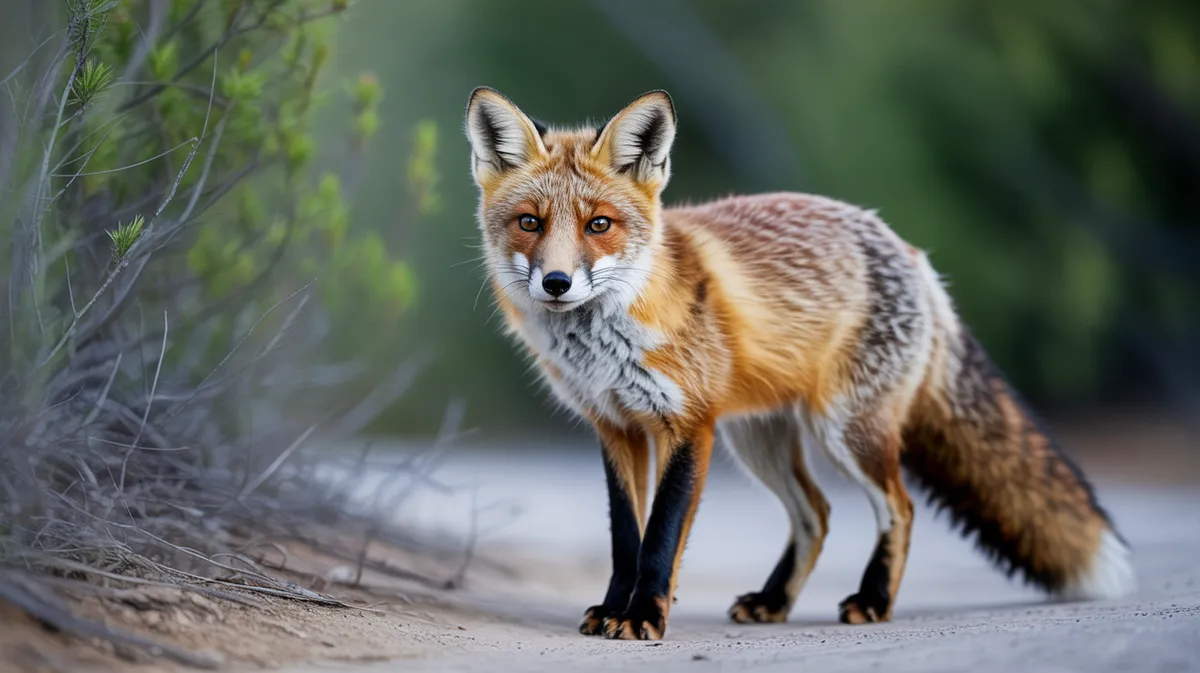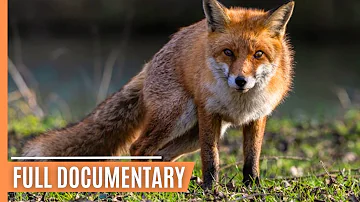
Red Fox
Vulpes vulpes

Meet the Red Fox
The red fox is a highly adaptable and widespread canid native to the Northern Hemisphere. Characterized by its striking reddish-orange fur, bushy tail tipped with white, and black legs, it thrives in diverse habitats, from forests and grasslands to urban environments. Red foxes are primarily nocturnal and are known for their intelligence and cunning behavior. They communicate using a wide range of vocalizations and scent markings, and their diet is highly varied, reflecting their opportunistic nature.
Classification
Mammal
Habitat
Forests, grasslands, mountains, deserts, and urban areas
Diet
Omnivore
Lifespan
3-6 years in the wild, up to 14 years in captivity
Conservation
Least Concern
Weight
2.2–14 kg (4.9–31 lbs)
📖Fascinating Facts
Wide Distribution
The red fox is found across North America, Europe, Asia, and even parts of North Africa and Australia.
Keen Hearing
Red foxes can hear low-frequency sounds and use this ability to detect rodents digging underground.
Urban Adaptation
Red foxes have successfully adapted to living in cities, where they scavenge for food and use parks and gardens as territory.
📋Detailed Description
The red fox (Vulpes vulpes) is the largest member of the true foxes, with adults typically weighing between 3.6–7.6 kg (8–17 lbs) and measuring 45–90 cm (18–35 in) in body length, excluding the bushy tail, which adds another 30–55 cm (12–22 in). Its dense, soft fur varies in color from deep reddish-orange to silver or black, with a characteristic white-tipped tail and black markings on the legs and behind the ears. The red fox has a slender, elongated muzzle, upright triangular ears, and sharp, curved canine teeth adapted for a carnivorous diet. Its senses of hearing and smell are highly developed, enabling it to detect prey underground or at great distances. Red foxes are highly adaptable, occupying a wide range of habitats from tundra and boreal forests to deserts and urban landscapes. They are primarily solitary outside of the breeding season, though family groups may form around a breeding pair and their offspring. Red foxes are crepuscular to nocturnal, with peak activity at dawn and dusk. Their vocal repertoire is extensive, including barks, screams, and 'gekkering' used in social interactions. The species exhibits remarkable behavioral flexibility, which, combined with its omnivorous diet, underpins its success across diverse environments.
💡 Did you know?
Despite their name, not all red foxes are red—some can be silver, black, or cross-colored due to genetic variation.
🔬Research & Sources
Wikipedia Summary
The red fox is the largest of the true foxes and one of the most widely distributed members of the order Carnivora, being present across the entire Northern Hemisphere including most of North America, Europe and Asia, plus parts of North Africa. It is listed as least concern on the IUCN Red List. Its range has increased alongside human expansion, having been introduced to Australia, where it is considered harmful to native small and medium-sized rodents and marsupials. Due to its impact on native species, it is included on the list of the "world's 100 worst invasive species".
Last Modified: 5/23/2025
🎭Behavior & Social Structure
Red foxes are opportunistic feeders, employing a variety of hunting techniques such as stalking, pouncing, and caching surplus food for later consumption. Their diet includes small mammals (especially rodents and lagomorphs), birds, insects, fruits, and carrion, with regional and seasonal variation. In urban areas, they scavenge human refuse and prey on domestic poultry or small pets. Red foxes are generally solitary hunters, but social interactions occur within family groups, especially during the breeding season. They communicate through a complex system of vocalizations, body language, and scent marking using urine, feces, and secretions from anal glands. Territorial boundaries are established and defended primarily by resident pairs. Daily routines are influenced by food availability, human activity, and weather, with individuals often using multiple dens within their territory for shelter and raising young.
👶Reproduction & Life Cycle
Red foxes are monogamous during the breeding season, which typically occurs from December to February in the Northern Hemisphere. After a gestation period of 49–58 days, the vixen gives birth to a litter of 4–6 kits (range 1–13) in an underground den. Both parents participate in rearing the young, with the male providing food while the female nurses the kits. Kits are born blind and helpless, opening their eyes at around 10–14 days and weaning at 4–6 weeks. Juveniles begin to emerge from the den at about one month old and are fully independent by autumn. Dispersal from the natal territory occurs in late summer or early fall, reducing inbreeding and promoting gene flow.
🛡️Adaptations & Survival
Red foxes exhibit a suite of physical and behavioral adaptations that facilitate survival in diverse environments. Their thick, insulating fur provides protection against cold climates, while their slender build and long legs enable swift, agile movement. The fox's acute hearing allows it to pinpoint the location of prey, even beneath snow or soil. Behavioral plasticity is a hallmark of the species, with flexible foraging strategies and denning behaviors that allow exploitation of both wild and anthropogenic resources. The ability to cache food and utilize a variety of den sites (natural burrows, hollow logs, or even human structures) further enhances their resilience. Evolutionarily, the red fox displays significant genetic diversity and local adaptation, contributing to its broad geographic range.
🎨Cultural Significance
The red fox holds a prominent place in human culture, folklore, and mythology across its range. It is often depicted as a symbol of cunning, intelligence, and adaptability in European, Asian, and Native American traditions. In Japanese folklore, the fox (kitsune) is a shape-shifting spirit associated with both benevolence and trickery. In Western literature, the fox is a common character in fables and fairy tales, such as Aesop's 'The Fox and the Grapes.' Historically, red foxes have been hunted for sport and fur, and their pelts remain valuable in the fur trade. In some cultures, foxes are regarded as pests or vermin, while in others they are protected or revered.
🔬Recent Research & Discoveries
Recent research has focused on the red fox's remarkable adaptability to urban environments, including studies on diet, spatial ecology, and behavioral changes in response to human presence. Genetic analyses have revealed significant regional variation and evidence of hybridization with closely related species in some areas. Ongoing studies investigate the role of red foxes in disease ecology, particularly as reservoirs for rabies and Echinococcus multilocularis. Conservation research in Australia examines the impact of fox predation on endangered native species and evaluates the effectiveness of control measures. Advances in GPS tracking and camera trapping have enhanced understanding of fox movement patterns, territory size, and social dynamics.
🎥Wildlife Videos

A Fox's Tale: Survival in the Alpine Wild | Free Documentary Nature
A Fox's Tale: Survival in the Alpine Wild | Wildlife Documentary Watch 'Megeti - Ethiopia's Lost Wolf' here: ...
Free Documentary - Nature

Wildlife in Unexpected Places - Foxes in Urban Environments | Full Documentary
Foxes are true survivors, at home in all regions of the Earth. Nowadays, the smart animals also feel at home in our cities. As an ...
Free High-Quality Documentaries

The Secret Life of Fox - Wildlife Wars (Nat Geo)
The fox is a scavenger carnivours dog generally found in urban city areas in the northern Hemisphere. The fox is a nocturnal ...
Exotic Nature Wildlife documentary

Red Fox Documentary
An interesting documentary on the ezo red fox which is a subspecies of red fox widely distributed in Hokkaido, Sakhalin, the Kuril ...
Living Attractions

Fantastic Mr. Fox | Destination WILD
About National Geographic Wild: National Geographic Wild is a place for all things animals and for animal-lovers alike. Take a ...
Nat Geo Animals

Why the Red Fox May be the Most Resourceful Predator 🦊 Carpathian Predators | Smithsonian Channel
Here on the Carpathian mountains, the red fox has carved a unique niche for itself, underpinned by dietary flexibility and ...
Smithsonian Channel
🌍Habitat Information
The Red Fox typically inhabits Forests, grasslands, mountains, deserts, and urban areas environments. Red Foxs have adapted to their environments with specialized features and behaviors.
Primary Habitat:
Forests, grasslands, mountains, deserts, and urban areas
More detailed habitat information will be available soon.
🛡️Conservation Status
The Red Fox is currently classified as Least Concern. Conservation efforts are crucial for preserving this species for future generations.
Common Threats:
- 🏠Habitat loss and fragmentation
- 🌡️Climate change impacts
- 🎯Hunting and poaching
- 🏭Human-wildlife conflict
⚠️Threats & Conservation Challenges
Globally, the red fox faces few natural predators, though young may fall prey to large birds of prey, wolves, or coyotes. Human-related threats include habitat fragmentation, vehicle collisions, persecution (trapping, hunting, poisoning), and disease transmission (notably rabies and mange). In regions where it is introduced, such as Australia, the red fox is a significant threat to native fauna, leading to population control measures. Despite localized declines due to intensive control or disease outbreaks, the global population is stable or increasing, with the IUCN listing the species as Least Concern. Climate change poses potential future challenges by altering prey availability and habitat suitability.
🔬Scientific Classification
Scientific Name
Vulpes vulpes
Classification Hierarchy
🔍 About Taxonomic Classification
Taxonomic classification is a hierarchical system used by scientists to classify and organize living organisms based on shared characteristics and evolutionary relationships.
The system moves from broad categories (Kingdom) to increasingly specific ones, with each animal's scientific name typically consisting of its Genus and species.
📝Community Notes
Share your observations and insights about the Red Fox with our community of wildlife enthusiasts.
Join Our Community
Sign in to share your observations and connect with fellow wildlife enthusiasts.
Sign In to ContributeNo community notes yet
Be the first to share your observations about the Red Fox!
Explore Red Fox
Select a tab above to learn more about this amazing animal.
📸Photo Gallery
No photos available for this animal yet.
🌟Discover More Wildlife
Continue your journey of discovery with more fascinating animals from our database
